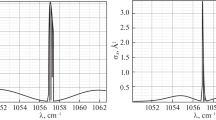Abstract
A new optimization criterion for iterative zirconium isotope recovery by laser-assisted retardation of condensation is introduced. Generally, the optimization should be performed over the following set of parameters: gas flow pressure and temperature, target gas molar fraction, laser pulse intensity, laser beam radius, nozzle throat height and width, total processing time (number of iterations), and irradiation cell length. The laser intensity variation range should satisfy the condition of applicability of the isotope separation method used, and temperature in the mixing tank should be high enough to prevent condensation of the target gas. The evolution of the objective function for zirconium isotope separation has been evaluated as a function of the gas flow core temperature at different ambient gas pressures.

Similar content being viewed by others
References
R. V. Ambartsumyan, V. S. Dolzhikov, V. S. Letokhov, E. A. Ryabov, and N. V. Chekalin, “Investigation of the dissociation of BCI\(_3\) molecules in the field of an intense CO\(_2\) laser pulse,” Sov. Phys. JETP 42 (1), 36–41 (1975) [transl. from Zh. Eksp. Teor. Fiz. 69 (1), 72–83 (1975)].
V. M. Apatin et al., “Laser separation of nitrogen isotopes by the IR + UV dissociation of ammonia molecules,” Quantum Electron. 38 (8), 775–782 (2008) [transl. from Kvant. Elektron. 38 (8), 775–782 (2008)].
V. Yu. Baranov et al., “Production of carbon isotopes by laser separation,” in Progress in Research and Development of High-Power Industrial CO\(_2\) Lasers (SPIE, Bellingham, WA, 2000), Proc. SPIE 4165, pp. 314–323.
J. L. Burmeister, E. A. Deardorff, A. Jensen, and V. H. Christiansen, “Bonding patterns in metallocene pseudohalide complexes,” Inorg. Chem. 9 (1), 58–63 (1970).
D. Dong, C. Zhang, H. Rabitz, A. Pechen, and T.-J. Tarn, “Incoherent control of locally controllable quantum systems,” J. Chem. Phys. 129 (15), 154103 (2008).
L. M. Dyagileva, L. I. Vyshinskaya, E. I. Tsyganova, and V. L. Ivanov, “Thermal decomposition of bis(cyclopentadienyl)dimethylzirconium,” Russ. J. Gen. Chem. 67 (5), 663–666 (1997).
J. W. Eerkens, “Equilibrium dimer concentrations in gases and gas mixtures,” Chem. Phys. 269 (1–3), 189–241 (2001).
J. W. Eerkens, “Laser-induced migration and isotope separation of epi-thermal monomers and dimers in supercooled free jets,” Laser Part. Beams 23 (2), 225–253 (2005).
J. W. Eerkens, J. F. Kunze, and L. J. Bond, “Laser isotope enrichment for medical and industrial applications,” in Proc. 14th Int. Conf. on Nuclear Engineering, Miami, FL, 2006 (ASME, New York, 2006), Vol. 3, pp. 483–492.
A. A. Granovsky, “Firefly computational chemistry program, version 8,” http://classic.chem.msu.su/gran/firefly/
Y. T. Lee, “Isotope separation by photodissociation of Van der Wall’s molecules,” US patent no. 4032306 (1977).
V. S. Letokhov and E. A. Ryabov, “Laser infrared multiphoton noncoherent control of intermolecular (isotope) selectivity for polyatomic molecules on a practical scale,” Isr. J. Chem. 44 (1–3), 1–7 (2004).
K. A. Lyakhov, H. J. Lee, and A. N. Pechen, “Some issues of industrial scale boron isotopes separation by the laser assisted retarded condensation (SILARC) method,” Sep. Purif. Technol. 176, 402–411 (2017).
K. A. Lyakhov and A. N. Pechen, “CO\(_2\) laser system design for efficient boron isotope separation by the method of selective laser-assisted retardation of condensation,” Appl. Phys. B 126 (8), 141 (2020).
K. A. Lyakhov and A. N. Pechen, “Evolution of the enrichment factor for an iterative scheme of zirconium isotopes separation,” Lobachevskii J. Math. 41 (12), 2345–2352 (2020).
K. A. Lyakhov, A. N. Pechen, and H.-J. Lee, “The efficiency of one-line versus multi-line excitation of boron isotopes within the method of selective laser assisted retardation of condensation,” AIP Adv. 8 (9), 095325 (2018).
W. H. Miller and J. W. Eerkens, “Laser isotope separation employing condensation repression,” Preprint (Nucl. Sci. Eng. Inst., Univ. Missouri, Columbia, MO, 2004).
“Oerlikon Leybold Vacuum full line catalog,” http://www.leybold.com/epaper/en/
PAR Systems, “UT Series Laser,” http://www.par.com/technologies/pulsed-co2-lasers/atmospheric-tea-co2-lasers/ut-series-laser/
A. Pechen, N. Il’in, F. Shuang, and H. Rabitz, “Quantum control by von Neumann measurements,” Phys. Rev. A 74 (5), 052102 (2006).
A. Pechen and H. Rabitz, “Teaching the environment to control quantum systems,” Phys. Rev. A 73 (6), 062102 (2006).
M. W. Schmidt et al., “General atomic and molecular electronic structure system,” J. Comput. Chem. 14 (11), 1347–1363 (1993).
R. Snyder, “A proliferation assessment of third generation laser uranium enrichment technology,” Sci. Global Secur. 24 (2), 68–91 (2016).
Funding
This work is supported by the Russian Science Foundation under grant 17-11-01388.
Author information
Authors and Affiliations
Corresponding author
Additional information
Published in Russian in Trudy Matematicheskogo Instituta imeni V.A. Steklova, 2021, Vol. 313, pp. 143–153 https://doi.org/10.4213/tm4172.
Rights and permissions
About this article
Cite this article
Lyakhov, K.A., Pechen, A.N. Constrained Optimization Criterion for Zirconium Isotope Separation by the Method of Laser-Assisted Retardation of Condensation. Proc. Steklov Inst. Math. 313, 131–141 (2021). https://doi.org/10.1134/S0081543821020139
Received:
Revised:
Accepted:
Published:
Issue Date:
DOI: https://doi.org/10.1134/S0081543821020139




